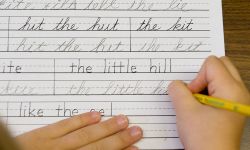In rural Michigan, teacher mourns coronavirus loss not counted in hospitals

Tara Olar wants you to know she’s trying. She’s trying probably harder than she has in her life.
The third-grade teacher in tiny Mayville, spent last week helping put together two weeks’ worth of worksheets and reading materials to be dropped in the mail for the elementary school’s 39 third-graders, the first phase in moving the rural school to remote learning.
She’s started an online Google Classroom for her “kiddos.” The school has tried to contact parents by phone and email to talk about how education will continue in the wake of Gov. Gretchen Whitmer’s executive order to close classrooms for the remainder of the school year.
In the end, Olar said, she knows it won’t be enough.
- The latest: Michigan coronavirus map, locations, updated COVID-19 news
- What Michigan's new coronavirus stay-at-home executive order means
- When Michigan unemployment, stimulus checks, and $600 CARES money will arrive
“They’re going to miss so much,” Olar said, beginning to cry on a phone call with a Bridge Magazine reporter. “I’m a good teacher, but I’m not a miracle worker.”
Coronavirus isn’t supposed to be a big deal here among the corn and bean fields of Michigan’s thumb, in a village that is a traffic signal short of being a one-stoplight town.
As of Saturday in all of Tuscola County, there had been 40 confirmed cases of coronavirus. Wayne County added 15 times that many cases on Saturday alone.
But from Olar’s now shuttered rural classroom, the pandemic’s losses aren’t measured with nasal swabs and body bags, but in the learning that will slip from young minds between March 16, when schools closed because of the deadly virus, and September when they are currently scheduled to reopen.
“In my heart of hearts,” she said, her voice cracking, “I know it’s going to affect them … missing so much school.”
During a normal summer break, students can lose as much as a month’s worth of instruction, with low-income students suffering the most. In the 2018-19 school year, 80 percent of Mayvillle’s third-graders were considered economically disadvantaged by the Michigan Department of Education; by comparison, about half were economically disadvantaged across the state.
Though some recent studies indicate summer learning loss doesn’t always occur, some teachers who spoke to Bridge say they typically spend up to a few weeks at the beginning of the school year re-teaching skills learned the previous spring.
That loss occurs in a normal summer break between school years, which in Michigan is about 10 weeks.
This year, if schools reopen Sept. 8, the Tuesday after Labor Day as is traditional for most Michigan schools, students will be out of classrooms for 25 weeks.
What will be the impact on learning of almost six months outside a classroom?
“It is difficult to say with precision, but we all have to admit that there will be losses—big losses,” said Elizabeth Birr Moje, dean of the University of Michigan School of Education.
She praised Michigan teachers who are scrambling to develop remote learning opportunities for their children. But teaching remotely, through online check-ins for students with Internet access and packets of materials for those who do not, likely will only mitigate large learning loss rather than erase them, Moje said.
Michigan State University researchers from the Institute for Public Policy and Research and the Education Policy Innovation Collaborative teamed up for a similarly blunt assessment.
In a statement released last week, the MSU research groups said state and local leaders “should expect students to return to school in Fall 2020 behind where they would have been in a normal school year, even without considering the trauma and dislocation associated with the pandemic.”
The MSU researchers offered further warnings:
- The pandemic-driven school closures will increase inequalities across school districts, and between students within schools.
- Learning loss will be concentrated in low-income schools and students.
- The learning loss will be largest in schools hard hit by the pandemic, which presumably would include communities like Detroit, the epicenter of COVID-19 cases and deaths in Michigan and a school district with high rates of poverty and low levels of student achievement.
- There will be an increase of students in need of remedial education.
When Whitmer issued her executive order closing schools for the remainder of the year April 2, she acknowledged the blow to students’ academic achievement. “There is no video chat or homework packet that can replace the value of a highly trained, experienced teacher working with students in a classroom,” Whitmer said that day, “but we must continue to provide equitable educational opportunities for students during this public health crisis.”
The executive order offered school districts the option of adding summer school or opening earlier than Michigan’s traditional school opening after Labor Day.
In one notable example, Nikolai Vitti, superintendent of Detroit Public Schools Community District, the largest district in the state, has said he would like to offer a more robust summer school program than usual this year to mitigate the learning loss from this spring's school closure.
The statement from MSU researchers recommended a longer school year next year or longer school days to address expected learning loss.
“Students are unlikely to catch up on lost learning time and succeed in meeting standards for the next academic year without expanded instructional time,” according to the researchers.
Whitmer’s executive order did not appear to address whether any state funds would be available to school districts for those additional days.
U-M’s Moje acknowledged that students will lose some school learning by the fall, but cautioned against state leaders — or parents — labeling them as “behind.”
“The question is ‘behind what?’” she said.
“Not only is everyone — globally — in the same position, it is also the case that we have accelerated our expectations for children in dramatic ways in the last 30 years. Rather than assume that the children are ‘behind’ some imaginary standard, we will have to meet children where they are and help them achieve new heights.”
‘Starting from scratch’ in fall
In Mayville, before schools closed March 16, third-grade teacher Olar said she was worried some of her students would score so low on the reading portion of the state’s standardized test, the M-STEP, that the state would recommend they be held back in grade. The 2019-20 school year was to be the first year in which third-graders could be retained for poor reading skills under Michigan’s so-called “read-or-flunk” law.
The Michigan Department of Education had projected that up to 5 percent of third-graders (about 5,000 statewide) could be flagged for possible retention.
Olar’s Mayville classroom is one of four third-grade classes Bridge had been following this school year to examine the impact of the reading law on schools, teachers and students.
With schools closed to stem the spread of the coronavirus before the M-STEP was given to students, the law is being delayed for a year. All of Olar’s third-graders will advance to fourth grade.
That’s some solace to the veteran teacher, but she said she worries about the long-term academic damage of being out of school for so long.
“The second-graders coming in, they’re going to be even farther behind,” Olar said. “This group of kiddos that are coming in, there are already low [reading test scores] coming in, and they have emotional and disciplinary problems coming in. This is going to add to it.
“There’s going to be a lot of starting from scratch for some of them.” Olar said.
She’s trying, she said. But there’s only so much she can do in the face of a pandemic.
“We like to think we are superheroes and can teach these kids and get them up to level,” Olar said. “Even normally, we’ve got so many things that are involved in our children’s education outside of schools that is always against us.
“When you put something like this on top of it? It’s …” the teacher’s voice cracked, “it’s … ugh.”
RESOURCES:
- Hey, Michigan, here’s how to make a face mask to fight coronavirus
- Michigan coronavirus dashboard: cases, deaths and maps
- Michigan families can get food, cash, internet during coronavirus crisis
- How to give blood in Michigan during the coronavirus crisis
- 10 ways you can help Michigan hospital workers right now
- Michigan coronavirus Q&A: Reader questions answered
- How to apply for Michigan unemployment benefits amid coronavirus crisis
Michigan Education Watch
Michigan Education Watch is made possible by generous financial support from:
Subscribe to Michigan Education Watch
See what new members are saying about why they donated to Bridge Michigan:
- “In order for this information to be accurate and unbiased it must be underwritten by its readers, not by special interests.” - Larry S.
- “Not many other media sources report on the topics Bridge does.” - Susan B.
- “Your journalism is outstanding and rare these days.” - Mark S.
If you want to ensure the future of nonpartisan, nonprofit Michigan journalism, please become a member today. You, too, will be asked why you donated and maybe we'll feature your quote next time!






